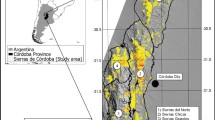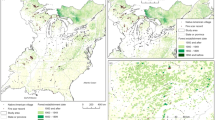Abstract
Patterns of fire occurrence within the Las Bayas Forestry Reserve, Mexico are analyzed in relation to variability in climate, topography, and human land-use. Significantly more fires with shorter fire return intervals occurred from 1900 to 1950 than from 1950 to 2001. However, the frequency of widespread fire years (25% filter) was unchanged over time, as widespread fires were synchronized by climatic extremes. Widespread fire years occurred during dry years that lagged wet years. Widespread fire years lagged the negative El Niño phase (wet winters) of the Southern Oscillation by 1 year, but were not synchronized by the positive, La Niña phase (dry winters) of the Southern Oscillation. The smaller, localized fires that occurred more frequently during the first half of the 20th century were attributed to changes in land tenure with the introduction of the ejido system in the early 1950s. Ejido management strategies lowered fire frequencies by suppressing fires and reducing anthropogenic fires. There were likely more ignitions prior to the arrival of the ejido system as fires were ignited by lightning and indigenous people. As the movement of indigenous peoples across the landscape has been restricted by changes in land tenure, numbers of human-ignited fires subsequently decreased post 1950. After 1950, fires occurred less frequently, were more synchronized, and more restricted to years of extreme climate.





Similar content being viewed by others
References
Agee JK (1998) The landscape ecology of western forest fire regimes. Northwest Sci 72:23–34
Arno SF, Sneck KM (1977) A method for determining fire history in coniferous forests of the mountain west. USDA Forest Service General Technical Report INT–42
Baisan CH, Swetnam TW (1990) Fire history on a desert mountain range: rincon mountain wilderness, USA. Can J For Res 20:1559–1569
Baker WL, Veblen TT, Sherriff RL (2007) Fire, fuels, and restoration of ponderosa pine-douglas-fir forests in the rocky mountains, USA. J Biogeogr 34:251–269
Beers TW, Dress PE, Wensel LC (1966) Aspect transformation in site productivity research. Am Sci 54:691–692
Brown DE, Reichenbacher F, Franson SE (1995) A Classification System and Map of the Biotic Communities of North America. In: Biodiversity and management of the Madrean archipelago: the sky islands of southwestern United States and northwestern Mexico. US Forest Service General Technical Report RM-GTR-264: pp 109–125
Bye R (1995) Prominence of the Sierra Madre Occidental in the biological diversity of Mexico. In: Biodiversity and management of the Madrean archipelago: The sky islands of southwestern United States and northwestern Mexico. US Forest Service General Technical Report RM-GTR-264: pp 19–27
Cavazos T, Hastenrath S (1990) Convection and rainfall over Mexico and their modulation by the Southern Oscillation. Int J Climatol 10:377–386
Cleaveland MK, Stahle DW, Therrell MD, Villanueva J, Buns BT (2003) Tree-ring reconstructed winter precipitation and tropical teleconnections in Durango, Mexico. Clim Change 59:369–388
Cooper CF (1960) Changes in vegetation, structure, and growth of southwestern pine forests since white settlement. Ecol Monogr 30:129–164
Diaz SC, Touchan R, Swetnam TW (2001) A Tree-Ring reconstruction of past precipitation for Baja California Sur, Mexico. Int J Climatol 21:1007–1019
Diaz SC, Therrell MD, Stahle DW, Cleaveland MK (2002) Chihuahua (Mexico) winter-spring precipitation reconstructed from tree-rings 1647–1992. Clim Res 22:237–244
Dieterich JH (1980) The composite fire interval — a tool for more accurate interpretation of fire history. In: Proceedings of the fire history workshop, Oct. 20–24, 1980, Tucson, AZ. US Forest Service General Technical Report RM-81: pp 8–14
Dieterich JH, Swetnam TW (1984) Dendrochronology of a fire-scarred ponderosa pine. For Sci 30:238–247
Douglas MW, Maddox RA, Howard KW, Reyes S (1993) The Mexican monsoon. J Clim 6:1665–1677
Drury SA (2006) The effects of climate and disturbance on Madrean pine–oak forests in Mexico’s Sierra Madre Occidental. Dissertation. University of Colorado, Boulder, Colorado, USA
Duncan RP (1989) An evaluation of errors in tree age estimates based on increment cores in Kahikatea (Dacrycarpus dacrydioides). N Z Nat Sci 16:31–37
Ehle DS, Baker WL (2003) Disturbance and stand dynamics in ponderosa pine forests in Rocky Mountain National Park, USA. Ecol Monogr 73:543–566
Felger RS, Johnson MB (1995) Trees of the northern Sierra Madre Occidental and sky islands of southwestern North America. In: Biodiversity and management of the Madrean archipelago: The sky islands of southwestern United States and northwestern Mexico. US Forest Service General Technical Report RM-GTR-264:pp 71–83
Fulé PZ, Covington WW (1997) Fire regimes and forest structure in the Sierra Madre Occidental, Durango, Mexico. Acta Botanica Mexicana 41:43–79
Fulé PZ, Covington WW (1999) Fire regime changes in the La Michilia Biosphere Reserve, Durango, Mexico. Conserv Biol 13:640–652
González-Elizondo M, Jurado E, Navar J, González-Elizondo MS, Villanueva J, Aguirre O, Jimenez J (2005) Tree-rings and climate relationships for Douglas-fir chronologies from the Sierra Madre Occidental Mexico: a 1681-2001 rain reconstruction. For Ecol Manage 213:39–53
Gray ST, Betancourt JL, Fastie CL, Jackson ST (2003) Patterns and sources of multidecadal oscillations in drought sensitive tree-ring records from the central and southern Rocky Mountains. Geophysical Research Letters 30 (6), 1316. doi:10.1029/2002GL016154
Gray ST, Graumlich LJ, Betancourt JL, Pederson GT (2004) A tree-ring based reconstruction of the Atlantic Multidecadal Oscillation since 1567 A.D. Geophysical Research Letters 31, L12205. doi:10.1029/2004GL019932
Grissino-Mayer HD (1995) Tree-ring reconstructions of climate and fire history at El Malpais National Monument, New Mexico. PhD Dissertation. University of Arizona. Tucson, Arizona, USA
Grissino-Mayer HD, Swetnam TW (2000) Century scale climatic forcing of fire regimes in the American Southwest. The Holocene 10:213–220
Heyerdahl EK, Brubaker LB, Agee JK (2002) Annual and decadal influence of climate on fire regimes (1687–1994) of the Blue Mountains, USA. The Holocene 12:597–604
Heyerdahl EK, Alvarado E (2003) Influence of climate and land use on histoical surface fires in pine–oak forests, Sierra Madre Occidental, Mexico. In: Veblen TT, Baker WL, Montenegro G, Swetnam TW (eds), Fire and climatic change in temperate ecosystems of the western Americans. Springer-Verlag, New York, pp 196–217
Holmes RL (1986) Quality control of crossdating and measuring: a users manual for program COFECHA. In: Homes RK, Adams RK, Fritts HC (eds), Tree ring chronologies of Western North America: California, eastern Oregon and northern Great Basin. University of Arizona Press, Tucson, pp 41–49
Johnson EA, Van Wagner CE (1985) The theory and use of two fire history models. Can J For Res 15:214–220
Kaufmann MR, Regan CM, Brown PM (2000) Heterogeneity in ponderosa pine/Douglas-fir forests: age and size structure in unlogged and logged landscapes of central Colorado. Can J For Res 30:698–711
Kiladis GN, Diaz HF (1989) Global climatic anomalies associated with extremes in the Southern Oscillation. J Clim 2:1069–1090
Landres PB, Morgan P, Swanson FJ (1999) Overview of the use of the natural variability concepts in managing ecological systems. Ecol Appl 9:1179–1188
Lumholtz C (1902) Reprint edition 1973. Unknown Mexico: A record of five years exploration among the tribes of the western Sierra Madre; In: the tierra caliente of Tepic and Jalisco; and among the Tarascos of Michoacan, vol I. Original edition Charles Scribner’s Sons, New York. Reprint Edition: The Rio Grande Press, Inc. Glorieta, New Mexico
Metcalf SE, O’Hara SL, Caballero M, Davies SJ (2000) Records of late Pleistocene-Holocene climatic change in Mexico—a review. Quater Sci Rev 19: 699–721
Pennington CW (1969) The Tepehuan of Chihuahua: their material Culture. University of Utah Press, Salt Lake City
Ropelewski CF, Halpert MS (1986) North American precipitation and temperature patterns associated with the El Niño/Southern Oscillation (ENSO). Month Weather Rev 114:2352–2362
Sherriff RL, Veblen TT (2006) Ecological effects of changes in fire regimes in Pinus ponderosa ecosystems in the Colorado Front Range. J Veg Sci 17:705–718
Stahle DW, D’Arrigo RD, Krusic PJ, Cleaveland MK, Cook ER, Allan RJ, Cole JE, Dunbar RB, Therrell MD, Gay DA, Moore MD, Stokes MA, Burns BT, Villanueva-Diaz J, Thompson LG (1998) Experimental dendroclimatic reconstruction of the Southern Oscillation. Bull Am Meteorol Soc 79:2137–2152. (Data archived at the World Data Center for Paleoclimatology, Boulder, Colorado, USA.)
Stahle DW, Cleaveland MK, Therrell MD, Villanueva-Diaz J (1999) Tree-Ring reconstruction of winter and summer precipitation in Durango, Mexico, for the past 600 years. In: Karl TR (Program Chairman) 10th Symposium on Global Change Studies. 10–15 January 1999, Dallas, TX. American Meterological Society: Boston, MA, pp 317–318
Stokes MA, Smiley TL (1968) An introduction to tree-ring dating. University of Chicago Press, Chicago Il
Swetnam TW, Baisan CH (1996) Historical fire regime patterns in the southwestern United States since AD 1700. In: Allen CD (ed) Fire effects in southwestern forests. Proceedings of the second La Mesa fire symposium. US Forest Service General Technical Report RM-286: pp 11–32
Swetnam TW, Betancourt JL (2000) Fire-Southern Oscillations relations in the southwestern United States. Science 249:1017–1020
Taylor AH, Skinner CN (1998) Fire history and landscape dynamics in a late-successional reserve, Klamath Mountains, California, USA. For Ecol Manage 111:285–301
Veblen TT, Kitzberger T, Donnegan J (2000) Climatic and human influences on fire regimes in Ponderosa pine forest in the Colorado Front Range. Ecol Appl 10:1178–1195
Weaver H (1951) Fire as an ecological factor in the southwestern Ponderosa pine forests. J For 49:93–98
Yamaguchi DK (1991) A simple method for cross-dating increment cores from living trees. Can J For Res 21:414–416
Acknowledgments
This research was funded by the National Science Foundation (Award BCS 0201807) and the Beverly Sears Student Grants Program of the University of Colorado. For granting permission to conduct this research we thank the Universidad Juarez del Estado de Durango, the Instituto de Silvicultura e Industria de la Madera (ISIMA), and the Facultad de Ciencias Forestales. For information, logistical assistance, and/or research assistance, we thank Jorge Luis Bretado Velázquez, Esteban Pérez Canales, Raúl Solís Moreno, Efrén Unzueta Ávila, Luis Jorge Aviña Berúmen, Jeffrey R. Bacon, Socorro Mora Cabrales, Don José Gallegos, Eduardo Gallegos, Leon Gallegos, Guadalupe Ivonne Benicio, Bibiana Rivas Arzola, Anna Milan, Dave Stahle, Art Douglas, and Martha González-Elizondo. Emily Heyerdahl furnished some of the data used in the La Grulla study site.
Author information
Authors and Affiliations
Corresponding author
Rights and permissions
About this article
Cite this article
Drury, S.A., Veblen, T.T. Spatial and temporal variability in fire occurrence within the Las Bayas Forestry Reserve, Durango, Mexico. Plant Ecol 197, 299–316 (2008). https://doi.org/10.1007/s11258-007-9379-5
Received:
Accepted:
Published:
Issue Date:
DOI: https://doi.org/10.1007/s11258-007-9379-5




